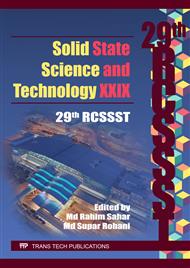p.274
p.279
p.287
p.292
p.297
p.305
p.311
p.315
p.320
Microwave Absorption Properties of Fe3O4-Graphene Nanohybrids
Abstract:
Magnetite (Fe3O4)-graphene nanohybrids having three different weight ratios of magnetite to graphene were synthesized by a facile in-situ deposition method. The combination of dielectric properties of graphene and magnetic properties of magnetite makes the nanohybrids an ideal choice of material for microwave absorption applications. In regards to that, the electromagnetic properties and microwave absorbing characteristics were investigated in a frequency range of 1-18 GHz. The reflection loss (RL) reaches a minimum of-40.44 dB at 6.84 GHz with a thickness of 7 mm for the sample containing 73 wt·% of Fe3O4. The bandwidth corresponding to the RL below-10 dB is 7.05 GHz. The as-prepared Fe3O4-graphene nanohybrids showed good microwave absorption ability in the low frequency band (C-band) which can be ascribed to improved impedance matching characteristics, enhanced interfacial polarizations as well as the magnetic loss contributions. Moreover, the frequency related to minimum RL could be tuned by varying the weight ratios of magnetite to graphene.
Info:
Periodical:
Pages:
297-301
Citation:
Online since:
October 2017
Authors:
Keywords:
Price:
Сopyright:
© 2017 Trans Tech Publications Ltd. All Rights Reserved
Share:
Citation:


